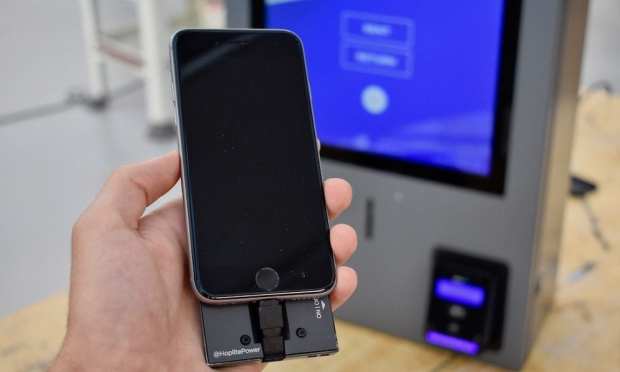Smartphone Charger Kiosks Vie To Make Stadium Lineups

With the constant power demands of phone calls, picture taking and apps, consumers may find it challenging to keep their cell phones charged. Like many smartphone owners, Hoplite Power Co-Founder and CEO Jordan Mayerson faced this problem in his own life before he went out to find a solution. “I’ve been plagued by dead batteries on all my phones for years now,” Mayerson told PYMNTS in an interview. After seeing stationary systems in New York, which were primarily charging lockers, he wondered how to add mobility into the equation and build a better mousetrap for cell phone charging.
To bring that solution to consumers looking to power their smartphones, his company rents chargers from kiosks. When consumers arrive at a Hoplite Power kiosk, they are presented with the choice to rent or return a charger. Once consumers choose the option to rent, the machine brings them to a page that has pricing details as well as terms and conditions. They then can choose a battery type matched for their particular kind of phone. If they have an iPhone, for instance, they may need compatibility with a lightning connector.
Once they agree to the terms and select a battery, they can make a payment via card (not cash). If the transaction is valid, the machine will vend a fully charged battery pack as soon as the card is processed. The charging cable is integrated into the pack, so consumers don’t have to bring cables when they go to charge their phones. All they need to do is press power on the pack and plug it into their phones. They then can take the devices with them and charge their devices wherever they want. If they are at a sporting event, for instance, they can take a charger with them and walk around the stadium.
After consumers are finished using one of the company’s chargers, they can return it to any kiosk in the company’s network. (In other words, they don’t have to bring the pack to the place where they picked it up.) Once consumers return to one of the company’s locations to make a return, they can stick the battery back into the kiosk. The kiosk recognizes the pack, pulls it back inside, and registers that the rental is complete. Consumers are then on their way — with a cell phone that has an extra boost of energy.
The Model
To prevent people from borrowing a charger and not returning it to a kiosk, the company has a two-fold solution on its new machine. One approach is technological, while the other is financial. For starters, the company can charge follow-up usage fees. It offers a single price with the initial return period for 24 hours. “We’re not looking to meter,” Mayerson said. The customer is charged the same price whether they use a charger for 30 minutes or for 23 hours. It’s up to the consumer on how long he or she wants to use the battery pack for the up to 24 hours.
After that point, Mayerson says the company reserves the right to charge late fees and a penalty fee. (If the battery pack is deemed to be lost after a week, the customer is charged a lost battery replacement fee.) And, if customers do hold onto the battery pack, it doesn’t have much use once it’s drained of power. “You have no way to recharge it,” Mayerson said. The company has integrated a proprietary charger interface: It is not charged over, say, Micro USB. The charger itself was designed for mobility and “charging on-the-go,” Mayerson said. He says it was not going to be a bulky brick that makes it challenging to take a phone call, picture or text.
Each battery pack has a specific cable that is integrated. Hoplite Power has one for Apple, one for Micro USB and one for USB. By comparison to other alternatives, Mayerson says consumers gain convenience from his solution that doesn’t require them to leave their devices in lockers or stay tethered to walls. When it comes to locations, the company is targeting markets such as large entertainment facilities, sports complexes and marketplaces.
In other words, the company aims to serve places where an outlet will be impossible to find. At the same time, consumers don’t have to choose between charging their phones or enjoying a sporting event experience with his solution. And, when it comes to partner locations, Mayerson said the company is “providing them a service that they would look to be providing to their customers anyway.”
With the help of automated retail, digital innovators are aiming to provide consumers a way to recharge their smartphones through kiosks.
